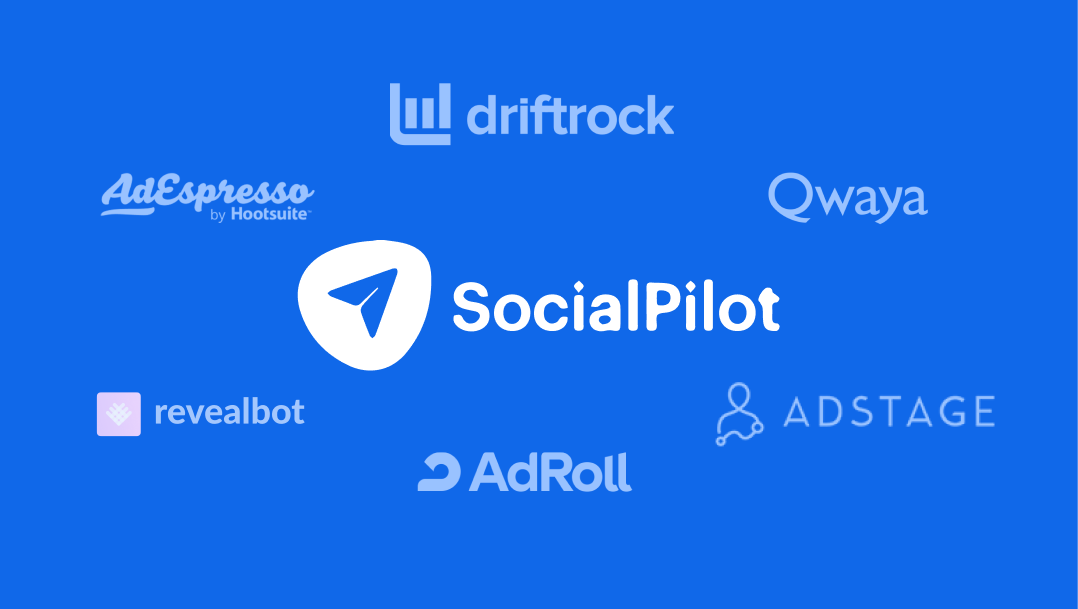Mention algorithms change, and every marketer turns purple with a chill running down their spine. And especially when it’s a Facebook algorithm change, the world comes to a standstill.
Why?
As per 2023 latest statistics, Facebook has 2.74 billion monthly active users, with an average of 1.82 billion logins per day. A countless number of businesses invest in Facebook with high hopes to go viral.
But it all shatters when algorithms change and the existing Facebook marketing strategy stops being relevant. How do you combat that?
Today we shall be decoding it all – the Facebook new algorithms, best practices with some quick, handy tips too so you get the right engagement. You can also download our Facebook Marketing ebook for free to create Facebook strategies right from scratch.
So let’s dive right in.
Understanding the Facebook Algorithm and Its Significance for Your Business
Facebook algorithms are AI and machine learning codes that aid Facebook in updating every profile’s newsfeed – what posts will be shown in what order and to whom.
They decide this based on user behavior and demographics. They ensure that the displayed content has a higher chance of interesting the users, who can then spend more time on the platform.
And why does that matter?
Because it indicates that they are high in quality. Facebook wants your posts to be watched longer or be showered with reactions and comments. They instantly prioritize such posts to appear more frequently on Facebook users’ feeds and go viral.
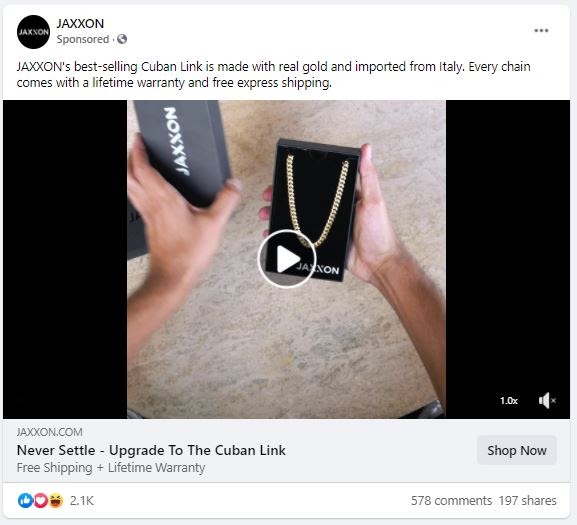
Look at this post by Jaxxon, a male luxury brand that knows how to leverage Facebook new algorithm to its advantage. Their sponsored post is a video showcasing their product. It did well, receiving a great response of 2.1k reactions and 500+ comments and, as a result, got an extra engagement push.
Exploring the Evolution of the Facebook Algorithm: How Does It Work?
It is very important for marketers to understand how social media algorithms work, and it applies to every network. Facebook took various surveys and wanted to know about their users’ close friends, go-to brands, liked pages, their most interacted groups, and more.
It was followed by a new Facebook newsfeed algorithm that keeps the low engaging content lower in your feed, and the interesting ones appear outright.
Facebook started taking the following things into account:
- What types of posts you usually like: video, carousel, images, links, etc.
- With whom do you interact most frequently
- Post popularity
Mark Zuckerburg also shares the same saying that the Facebook newsfeed algorithm will show more posts from family and friends than shoving the sponsored ad posts down the throat.
Now it implies fierce competition for the limited business space. The one that scores the highest dominates this space. Scores are assigned to posts after active-passive signals and personalization factor checks.
Facebook has decided to keep its algorithm transparent by using these scores and signals. It was done to elevate the overall experience of Facebook users and for them to take part in meaningful interactions.

Here is an example of a recent Target post that received a high score. They posted a new year video expressing gratitude to their team for working relentlessly. The post got a fantastic response- 11k reactions with 1.2k+ comments and 2.4k+ shares.
This is how the score is determined:
- Inventory: A list of interesting posts ready to be displayed is created, which is called inventory.
- Signals: Signals from this inventory list convey to Facebook the nature of the post, as in what it is about. Active signals like reactions, comments, shares, and passive signals like watch duration, type, posted timings, etc., also come into play for ranking posts.
- Prediction: Facebook generates a quick prediction of how the Facebook user might react to the inventory posts based on past instances.
- Score: A score is assigned to these posts if the signals resemble the Facebook user’s likings. It is how posts make their appearance in the feed.
With every passing day, these algorithms are only getting better. If you get in the groove and align yourself with the process, it can be quite rewarding.
8 Best Practices to Crack the Facebook Algorithm in 2024
Despite the changes, some brands always excel. They felt the burn of the plummeting reach, but they are quick to rebound, making up for the speed bump.
What is the secret behind it? Let’s have a look at some insider’s best practices that you can follow right away.
1. Foster Engaging Conversations
Gone are the days when you would just push the post and breath a sigh of relief. Your audience demands more of you now. They want to feel connected.
Facebook groups are exemplary for kickstarting conversations. You can have multiple groups at your disposal for more in-depth and streamlined conversations.
“Facebook has prioritized posts in groups more and more over the past few years, so you can be pretty confident that if you post in a group, it will show up in the group members’ news feeds and notifications. That means if you’re trying to get feedback on an idea, get quotes for an article you’re working on, share a job posting, etc., Facebook groups are a great place to easily get in front of a lot of people.”

-Sujan Patel, Mailshake
Let them participate in your posts not just through reactions but with meaningful conversations. Make use of polls, ask them about their point of view, pain points, and more to garner their attention.
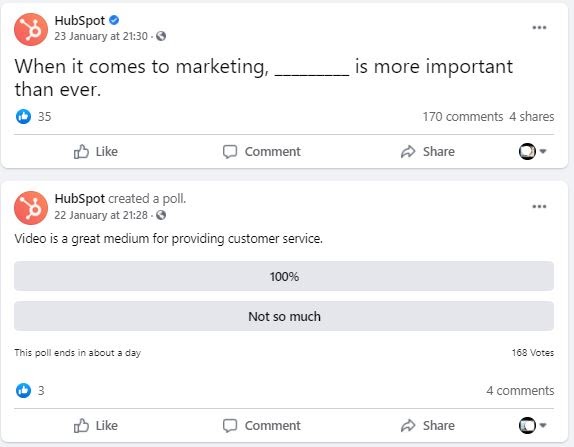
Hubspot nails it each time. They keep their posts short, crisp, and conversational. They have used the “Fill in the blanks” post and polls to get their followers’ responses. You can use something like this for your followers too.
2. Evoke Emotions
Despite your efforts, those cute cat memes are taking the limelight. And you already know why! Because that steers some deep emotions. You need to apply the same in your posts.
Your audience is remotely interested if you sound like another salesman-like bot. Connect with your audience so they can relate to your brand and create a lasting relationship. Value them, and they will swing right in.
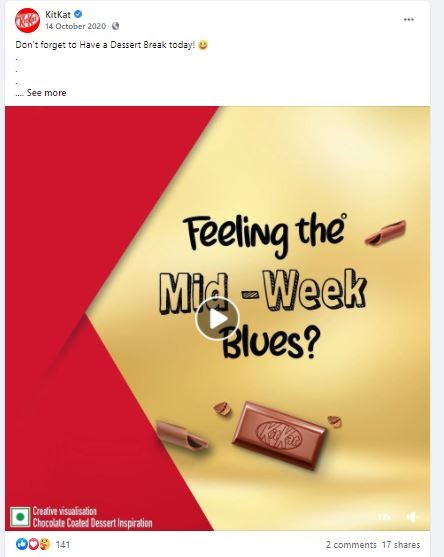
Here’s how Kitkat makes its followers smirk, asking a relatable question reminding them to have a sweet bite to kill boredom. You can use such content to steer the emotions of your audience.
3. Identify the Best Time to Post
Most B2B ventures notice good engagement on weekdays, B2C brands, on the other hand, witness an engagement leap during weekends.
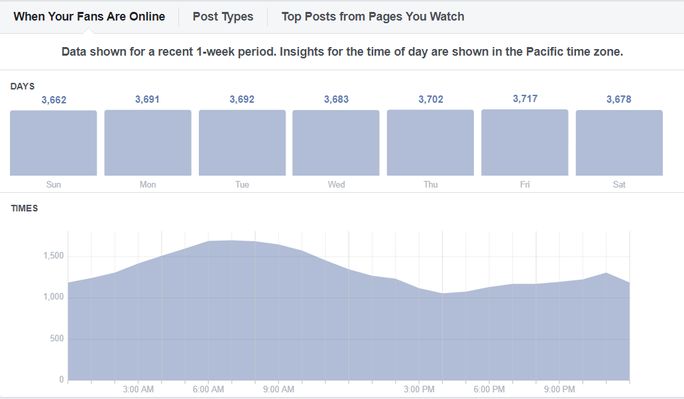
It is also a tested fact that the first hour of posting is the peak time of engagement. Find out when your audience is on board using Facebook Analytics and Insights for the best time to post on Facebook.
You can use post scheduling tools like SocialPilot to never miss out on posting at such crucial times.
4. Post Consistently
It is a fast-paced world, and things go out of fashion in days. You being a marketer, need to be on your toes to showcase the recent trends. It implies consistent posting with zero compromises on quality.
But by consistent, I don’t mean spamming. Hubspot took a survey where Facebook pages with less than 10k followers saw an engagement drop of 50% if posted multiple times on a single day.
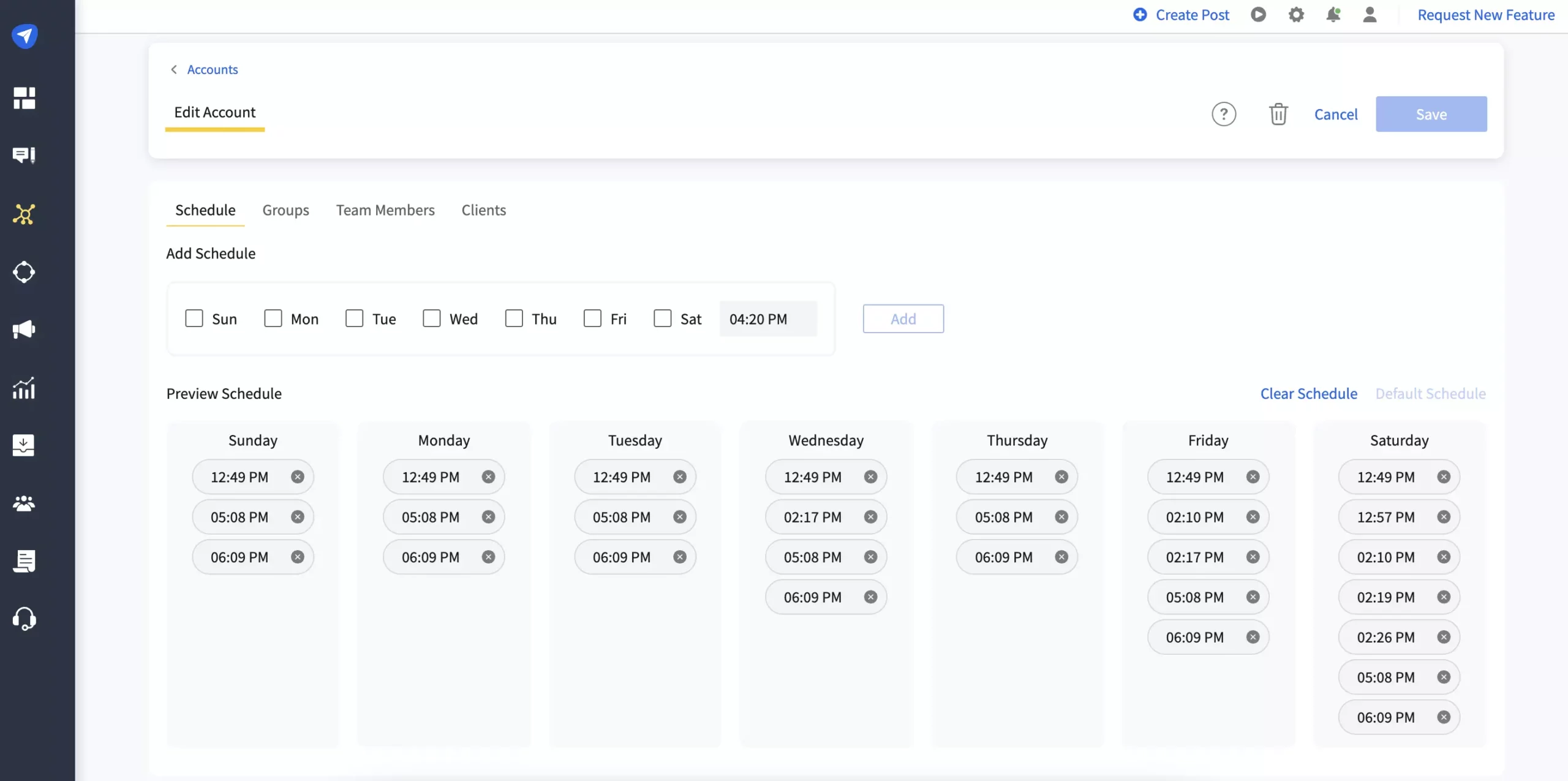
SocialPilot can help you here as well. You can schedule them at your convenience without a miss.
5. Leverage Influencer Marketing
According to BigCommerce, 89% of marketers claim that ROI from influencer marketing is better than most channels.
So if you want to be famous overnight, influencer marketing on Facebook can be a viable option.

Soccer king, Cristiano Ronaldo, is the biggest of all Facebook Influencers. With dripping engagement posts, his paid promotions are an instant success. Here is an example of collaboration between Ronaldo and Free Fire, a mobile gaming firm. The post has garnered 286k reactions with 10k comments and 4.1k shares.
6. Craft Compelling CTAs
Over the years, the audience has become more intellectual. They would not take any action that would not benefit them in any way.
Rather than baits, be friends with CTAs. They prompt your audience to take meaningful action that will be a win-win for both of you.
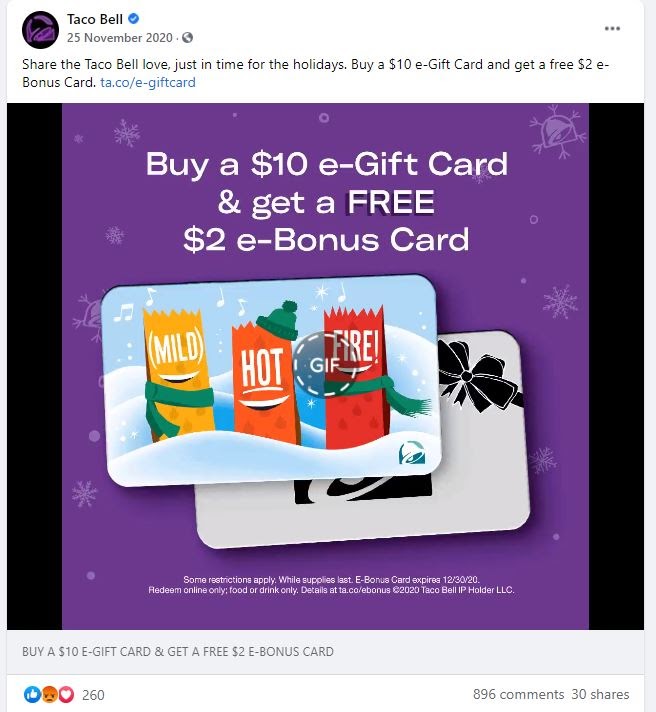
Have a look at this Taco Bell post that prompts its followers to buy their e-Gift cards to claim a bonus. CTAs like this are promising ways to turn your ad campaigns into rollicking success.
7. Track Performance
Facebook is rich with tracking tools like Pixel marketing tool and Facebook Ad Manager. In fact, it is one of the few platforms whose tracking is easily available within the platform.
Improvise your campaigns with a keen watch on metrics. Maybe KPIs need to be set right, or new studies are to be made. These groundworks will be fruitful in realizing your goals faster.
“The new algorithm shines a spotlight on two core timing factors. Posting out-of-hours when interaction is naturally low is likely to decrease your reach, while posting during peak hours is likely to elevate the reach of your content, making this an indirect factor of the algorithm. Another ramification of Facebook’s algorithm is that the time spent interacting with your content will mirror prioritisation.”

-Dennis Taylor, Real Business Rescue
8. Embrace Experimentation
Four billion+ videos are viewed each day on Facebook, yet only a handful of businesses use it. If you have not started it yet, then you are losing out on a lot.
The introduction of every Facebook new algorithm is focused on getting you to experiment with most of its new features- be it live, video, stories, events, etc. Experiment with not just the original postings but also with the ad types.
Conclusion
Let’s be honest. We cannot escape the algorithm change.
The only difference is that the successful brands adapt faster, using it to their advantage. Follow the best practices mentioned above to stay ahead of the Facebook algorithm curve.
And if you need a ready-made Facebook marketing strategy to save you time and brainstorming, we have something that you will love. It has got everything you need in one place, be it optimizing on Facebook ads or hitting massive reach with groups.
Download our Facebook Marketing ebook for free now and get ready for stellar marketing.
You got this!
.jpg)

